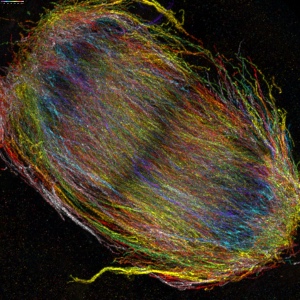Staff profile
Overview
https://apps.dur.ac.uk/biography/image/921

| Affiliation | Telephone |
|---|---|
| Head of Bioimaging in the Department of Biosciences | +44 (0) 191 33 41333 |
Biography
Bioimager | Industrial Collaborator | Passionate about Technology, Teaching and Engagement.
I’m a cell biologist and am Head of the core Bioimaging facility in the Department of Biosciences. I am also Deputy Director of the Durham Centre for Bioimaging Technology and the outreach co-ordinator for Biosciences.
Twitter: @BioimagingDurh1
Research Interests

My Research interests involve the use of a wide variety of imaging techniques to study 1) the cytoskeleton of plant and animal cells 2) the accessory proteins which control their dynamics and organisation and 3) their role in cell division, morphology and response to mechanical stress.
Some current projects
- Characterisation of members of the NET family of plant actin binding proteins which link the actin cytoskeleton to district membrane compartments (with Prof Hussey).
- Algae cell biology and the evolution of division arrays using the model O. tauri.
- Development of new imaging methodologies in particular for plant cells and tissues.
- Cell biology of Keratin associated proteins.
- Collaborations with industrial partners to develop new imaging approaches to help screen and understand their products and the fundamental biology behind them.
- Combining high-resolution imaging with mechanical manipulation and modelling in both animal and plants cells - As part of this programme we are developing a microscope-mountable mechanical platform for the precise controlled stretching/compression and high resolution imaging of elastic materials, cells and tissues. The mechanical platform incorporates high specification linear platforms (Zaber) and ISA miniature s-beam force transducers coupled with an FT-111 indicator for accurate stretching and force measurements respectively (flintec)
Lab Members
- Joanne Robson
- Dr Liv Kent
- Lydia Kitchen
Research interests
- Bioimaging
- Cell Biology
- Cytoskeletion
Publications
Chapter in book
- Hawkins, T. J., Robson, J. L., Cole, B., & Bush, S. J. (2023). Expansion Microscopy of Plant Cells (PlantExM). In The Plant Cytoskeleton (127-142). Springer. https://doi.org/10.1007/978-1-0716-2867-6_10
- Hussey, P., Deeks, M., Hawkins, T., & Ketelaar, T. (2019). Polar cell growth and the cytoskeleton. In K. Lindsey (Ed.), Polarity in Plants. Blackwell
Journal Article
- Tan, C. Y. R., Morenc, M., Setiawan, M., Lim, Z. Z. Y., Soon, A. L., Bierman, J. C., Vires, L., Laughlin, T., DeAngelis, Y. M., Rovito, H., Jarrold, B. B., Nguyen, T. Q. N., Lim, J. S. Y., Kent, O., Määttä, A., Benham, A. M., Hawkins, T. J., Lee, X. E., Ehrman, M. C., Oblong, J. E., …Bellanger, S. (2024). Para-Hydroxycinnamic Acid Mitigates Senescence and Inflammaging in Human Skin Models. International Journal of Molecular Sciences, 25(15), Article 8153. https://doi.org/10.3390/ijms25158153
- Hawkins, T. J., Kopischke, M., Duckney, P. J., Rybak, K., Mentlak, D. A., Kroon, J. T. M., Bui, M. T., Richardson, A. C., Casey, M., Alexander, A., De Jaeger, G., Kalde, M., Moore, I., Dagdas, Y., Hussey, P. J., & Robatzek, S. (2023). NET4 and RabG3 link actin to the tonoplast and facilitate cytoskeletal remodelling during stomatal immunity. Nature Communications, 14(1), Article 5848. https://doi.org/10.1038/s41467-023-41337-z
- Fang, B., Card, P. D., Chen, J., Li, L., Laughlin, T., Jarrold, B., Zhao, W., Benham, A. M., Määttä, A. T., Hawkins, T. J., & Hakozaki, T. (2022). A Potential Role of Keratinocyte-Derived Bilirubin in Human Skin Yellowness and Its Amelioration by Sucrose Laurate/Dilaurate. International Journal of Molecular Sciences, 23(11), Article 5884. https://doi.org/10.3390/ijms23115884
- Duckney, P., Kroon, J. T., Dixon, M. R., Hawkins, T. J., Deeks, M. J., & Hussey, P. J. (2021). NETWORKED2‐Subfamily Proteins Regulate the Cortical Actin Cytoskeleton of Growing Pollen Tubes and Polarised Pollen Tube Growth. New Phytologist, 231(1), 152-164. https://doi.org/10.1111/nph.17391
- Brault, M. L., Petit, J. D., Immel, F., Nicolas, W. J., Glavier, M., Brocard, L., Gaston, A., Fouché, M., Hawkins, T. J., Crowet, J., Grison, M. S., Germain, V., Rocher, M., Kraner, M., Alva, V., Claverol, S., Paterlini, A., Helariutta, Y., Deleu, M., Lins, L., …Bayer, E. M. (2019). Multiple C2 domains and transmembrane region proteins (MCTPs) tether membranes at plasmodesmata. EMBO Reports, 20(8), Article e47182. https://doi.org/10.15252/embr.201847182
- Pollastri, S., Jorba, I., Hawkins, T., Llusia, J., Michelozzi, M., Navajas, D., Penuelas, J., Hussey, P., Knight, M., & Loreto, F. (2019). Leaves of isoprene‐emitting tobacco plants maintain PSII stability at high temperatures. New Phytologist, 223(3), 1307-1318. https://doi.org/10.1111/nph.15847
- Johnson, S., Cowley, K., Hawkins, T. J., & Määttä, A. (2019). Pulling force deforms hair follicle root sheath nuclei and surrounding dermal collagen matrix differently at infundibulum, isthmus and suprabulbar regions. Experimental Dermatology, 28(7), 862-866. https://doi.org/10.1111/exd.13948
- Duit, R., Hawkins, T. J., & Määttä, A. (2019). Depilatory chemical thioglycolate affects hair cuticle and cortex, degrades epidermal cornified envelopes and induces proliferation and differentiation responses in keratinocytes. Experimental Dermatology, 28(1), 76-79. https://doi.org/10.1111/exd.13838
- Reipert, S., Goldammer, H., Richardson, C., Goldberg, M. W., Hawkins, T. J., Hollergschwandtner, E., Kaufmann, W. A., Antreich, S., & Stierhof, Y.-D. (2018). Agitation Modules: Flexible Means to Accelerate Automated Freeze Substitution. Journal of Histochemistry & Cytochemistry, 66(12), 903-921. https://doi.org/10.1369/0022155418786698
- Maruthappu, T., McGinty, L. A., Blaydon, D. C., Fell, B., Määttä, A., Duit, R., Hawkins, T., Braun, K. M., Simpson, M. A., O’Toole, E. A., & Kelsell, D. P. (2018). Recessive Mutation in FAM83G Associated with Palmoplantar Keratoderma and Exuberant Scalp Hair. Journal of Investigative Dermatology, 138(4), 984-987. https://doi.org/10.1016/j.jid.2017.10.031
- Duckney, P., Deeks, M., Dixon, M., Kroon, J., Hawkins, T., & Hussey, P. (2017). Actin–membrane interactions mediated by NETWORKED2 in Arabidopsis pollen tubes through associations with Pollen Receptor-Like Kinase 4 and 5. New Phytologist, 216(4), 1170-1180. https://doi.org/10.1111/nph.14745
- Wang, P., Hawkins, T., & Hussey, P. (2017). Connecting membranes to the actin cytoskeleton. Current Opinion in Plant Biology, 40, 71-76. https://doi.org/10.1016/j.pbi.2017.07.008
- Quinlan, R., Schwartz, N., Windoffer, R., Richardson, C., Hawkins, T., Broussard, J., Green, K., & Leube, R. (2017). A rim-and-spoke hypothesis to explain the biomechanical roles for cytoplasmic intermediate filament networks. Journal of Cell Science, 130(20), 3437-3445. https://doi.org/10.1242/jcs.202168
- Garagounis, C., Kostaki, K.-I., Hawkins, T. J., Cummins, I., Fricker, M. D., Hussey, P. J., Hetherington, A. M., & Sweetlove, L. J. (2017). Microcompartmentation of cytosolic aldolase by interaction with the actin cytoskeleton in Arabidopsis. Journal of Experimental Botany, 68(5), 885-898. https://doi.org/10.1093/jxb/erx015
- Wang, P., Richardson, C., Hawkins, T. J., Sparkes, I., Hawes, C., & Hussey, P. J. (2016). Plant VAP27 proteins: domain characterization, intracellular localization and role in plant development. New Phytologist, 210(4), 1311-1326. https://doi.org/10.1111/nph.13857
- Nelson, C., Duckney, P., Hawkins, T., Deeks, M., Laissue, P., Hussey, P., & Obara, B. (2014). Blobs and curves: object-based colocalisation for plant cells. Functional Plant Biology, 42(5), 471-485. https://doi.org/10.1071/fp14047
- Wang, P., Hawkins, T. J., Richardson, C., Cummins, I., Deeks, M. J., Sparkes, I., Hawes, C., & Hussey, P. J. (2014). The Plant Cytoskeleton, NET3C, and VAP27 Mediate the Link between the Plasma Membrane and Endoplasmic Reticulum. Current Biology, 24(12), 1397-1405. https://doi.org/10.1016/j.cub.2014.05.003
- Hawkins, T., Deeks, M., Wang, P., & Hussey, P. (2014). The evolution of the actin binding NET superfamily. Frontiers in Plant Science, 5, Article 254. https://doi.org/10.3389/fpls.2014.00254
- Palmer, A. J., Ford, S. H., Butler, S. J., Hawkins, T. J., Hussey, P. J., Pal, R., Walton, J. W., & Parker, D. (2014). Emissive europium complexes that stain the cell walls of healthy plant cells, pollen tubes and roots. RSC Advances, 4(18), 9356-9366. https://doi.org/10.1039/c3ra45426f
- Deeks, M. J., Calcutt, J. R., Ingle, E. K., Hawkins, T. J., Chapman, S., Richardson, A., Mentlak, D. A., Dixon, M. R., Cartwright, F., Smertenko, A. P., Oparka, K., & Hussey, P. J. (2012). at the Actin-Membrane Nexus of Higher Plants. Current Biology, 22(17), 1595-1600. https://doi.org/10.1016/j.cub.2012.06.041
- Piette, B., Liu, J., Peeters, K., Smertenko, A., Hawkins, T., Deeks, M., Quinlan, R., Zakrzewski, W., & Hussey, P. (2009). A Thermodynamic Model of Microtubule Assembly and Disassembly. PLoS ONE, 4(8), Article e6378. https://doi.org/10.1371/journal.pone.0006378
- Dixon, D., Hawkins, T., Hussey, P., & Edwards, R. (2009). Enzyme activities and subcellular localization of members of the Arabidopsis glutathione transferase superfamily. Journal of Experimental Botany, 60(4), 1207-1218. https://doi.org/10.1093/jxb/ern365
- Twell, D., Park, S., Hawkins, T., Schubert, D., Schmidt, R., Smertenko, A., & Hussey, P. (2002). MOR1/GEM1 has an essential role in the plant-specific cytokinetic phragmoplast. Nature Cell Biology, 4(9), 711-714. https://doi.org/10.1038/ncb844
- Hussey, P., Hawkins, T., Igarashi, H., Kaloriti, D., & Smertenko, A. (2002). The plant cytoskeleton: recent advances in the study of the plant microtubule-associated proteins MAP-65, MAP-190 and the Xenopus MAP215-like protein, MOR1. Plant Molecular Biology, 50(6), 915-924
- Hussey, P., & Hawkins, T. (2001). Plant microtubule-associated proteins: the HEAT is off in temperature-sensitive mor1. Trends in Plant Science, 6(9), 389-392
Supervision students
Abbi Farley
Research Postgraduate (PhD)
Benjamin Whyatt
Research Postgraduate (MSc)
Hanan Alhowty
Research Postgraduate (PhD)
Ianthe Doumas-Calder
Research Postgraduate (MSc)
Mr James Stevenson
Research Postgraduate (MSc)
Maryam Malik
Research Postgraduate (PhD)
Masi Yousefi
Research Postgraduate (PhD)
Simina Trufasu
Research Postgraduate (PhD)

